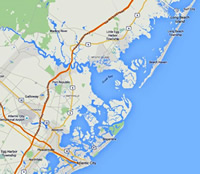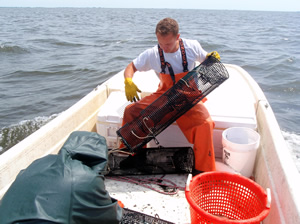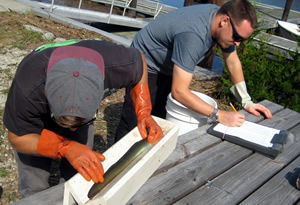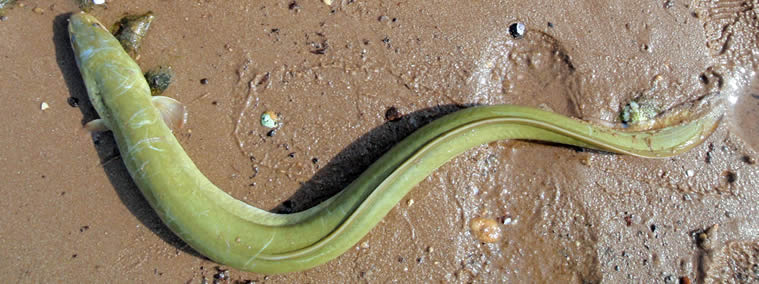 |
A Day on the Bay: On the Hunt for Yellow Eels |
|
by David Smithman, Hourly Fisheries Technician
Bureau of Marine Fisheries
June 30, 2016
|
At the NJDEP Division of Fish and Wildlife's Nacote Creek Research Station in Port Republic, the start of the spring season is apparent even to the untrained eye. Signs of life are all around; newborn geese waddle around the property, wild turkey calls echo through the pines, and dense schools of menhaden fill nearby tributaries. As the seasons change at Nacote Creek, so do our sampling priorities. For many, the start of spring simply means that warmer days are ahead; for a Fisheries Technician, these natural indices signal the beginning of the annual yellow eel (American eel) survey in Great Bay.
Unlike the Delaware River seine survey (see A Day on the Delaware River - Striped Bass Recruitment Survey), the yellow eel survey does not require a lengthy trip to distant sampling locations. A short walk to the dock behind the Bureau of Marine Fisheries office is all it takes to access the sampling grounds.
|
|
On an average Monday morning in May, you will find a small crew of 2-3 individuals on a 20-foot center console boat preparing to begin that week's sampling. This boat is loaded up with sixteen cylindrical pots, separated into four separate strings. Each pot is baited with frozen menhaden (bunker), and hauled out into the bay to be set at different locations. After the pots are set at each location, various environmental factors are recorded including air temperature, water temperature, salinity, dissolved oxygen levels, and pH.
|
|
As long as the weather cooperates, the crew will visit each string of pots on Wednesday to collect any eels that they have caught, re-bait each pot, and set them in the same location (any bycatch is also recorded and released). The pots will then soak for another 48 hours.
The crew heads back out on Friday to collect and record what they have caught once again. This time the pots are taken back to the dock to be safely stored for the weekend. When the following Monday rolls around the procedure is repeated, but the gear is set at four new sampling locations.
The yellow eels caught during this survey are transported back to the lab where they are measured, weighed, and marked with a harmless notch in their fin which can be used to recognize recaptured specimens. Because they are capable of absorbing oxygen through their skin, they are completely unscathed by their brief removal from their aquatic environment. Nonetheless, the eels are immediately returned to their natural habitat after being processed.
|
|
This survey was first developed in 2015 in an effort to establish a more accurate, coastwide stock assessment for the American eel. The Atlantic States Marine Fisheries Commission's 2010 stock assessment (which spans the entire east coast of North America) stated that total population numbers for the American eel are depleted. As a result, each state was asked to create more comprehensive life cycle surveys. Prior to this survey, New Jersey did not collect any data on the yellow eel stage.
Annual sampling of this species will allow for biologists to better understand trends in reproductive success and also present a clearer picture of their sexual maturation process.
|
|
Fish and Wildlife's yellow eel survey is conducted during May and June and the September-November period. The yellow eels targeted for this research are from one specific life phase which gives them their remarkable yellow to olive green pigment. These individuals are not yet sexually mature, but may be over 20 years old!
For more fascinating information about the life history of American eels please see The Incredible American Eel.
Back to A Day In the Life Of a Marine Fisheries Hourly
|




